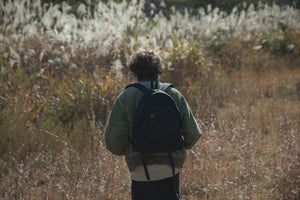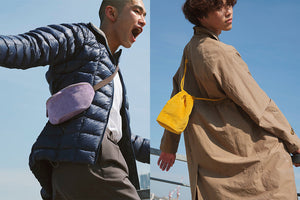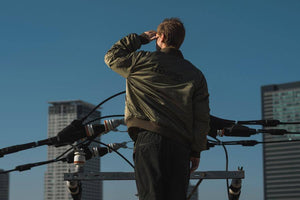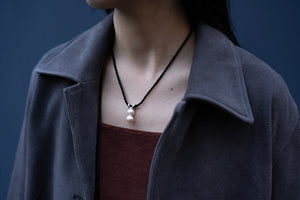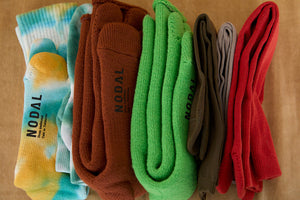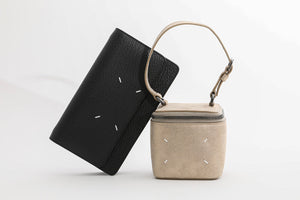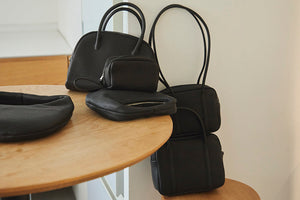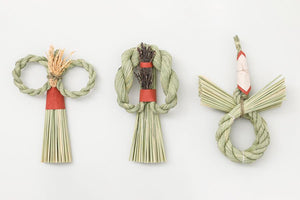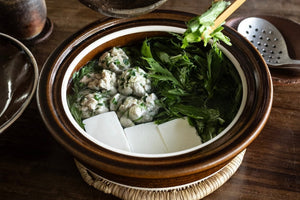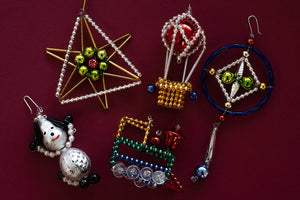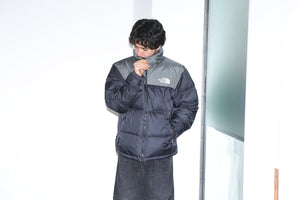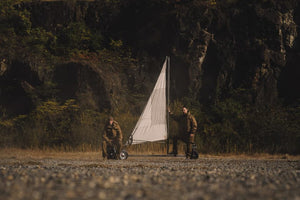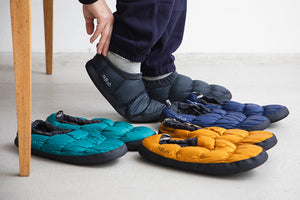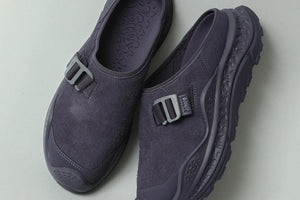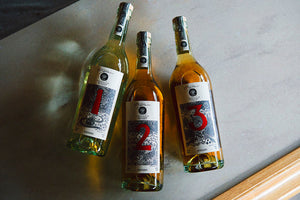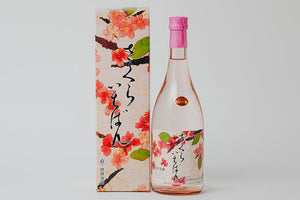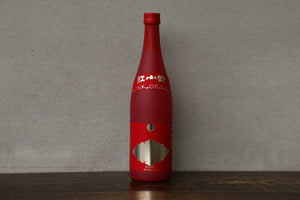
COVERCHORD FEATURE
TRUCK FURNITURE × hobo
THE CLASSIC BAG SERIES
HIROMI KARATSU Special Interview
Timeless appeal meets modern functionality
A special long interview ahead of the release
Saturday, September 23
Since their initial collaboration in 2014, hobo and TRUCK FURNITURE have joined forces on multiple endeavors, fostering a strong friendship and productive partnership along the way.
Now for their sixth iteration, they revisit the backpack that started it all, to create THE CLASSIC BAG SERIES which commemorates their union.
Designer of hobo, Hideki Asakura traveled to Osaka to visit Hiroki Karatsu from TRUCK FURNITURE, where they discussed their experiences of the collaboration processes and their shared philosophy towards craftsmanship.

HIROMI KARATSU
Special Interview
It’s a very real representation of “me”.
It’s my urban gear.
―We asked Hiromi Karatsu to bring her own hobo bag along to the interview to show us, and it’s clearly been well used.
Hiromi Karatsu (Karatsu): Yes it has! The fabric’s all soft now too from being used so much.
Hideki Asakura (Asakura): It’s made from nylon fabric, similar to the slightly thicker nylon fabric that was often used for bags in the 80s, but I specifically wanted to use a fabric that was a bit grainy rather than a uniform grey color.
Karatsu: Huh, I didn’t know that. Up until about four years ago I was going to the gym twice a week, and after training, I would do some boxing mitt practice to get some aerobic exercise. Whenever I was going to the gym, I’d just throw a pair of boxing gloves and a banana into my bag and jump on my bicycle.
―Do you not go to the gym anymore?
Karatsu: What with COVID I hadn’t been for about four years, but I actually just started going again in April this year. But at the moment I live next to the shop, our workshop is just across the road and we also now have a training gym on the premises as well, which means I don’t need to get changed anymore so I don’t need to carry so much stuff with me either.
―So for you, your bag is first and foremost a practical item, right? For some people, especially some women, a bag can be more of an accessory, I think.
Karatsu: Yeah, that’s not the case for me. (Laughs) For me, it’s as simple as “does it fit my gloves? Yes, then it’s perfect!”. I’m not at all interested in branded stuff and I don’t own any brand bags either. You know, the sort of bag that the sales assistant will wear gloves to handle.
―What do you normally carry around in your bag?
Karatsu: Hmm? Just the usual really.
―No quirks, like your bag’s always full of sticks of gum or something?
Karatsu: Oh, well if we’re talking about things like that, for me it’s not gum but sweets. There’s a brand of cough sweets called “Pelak”, and I’ve found that they’re the best for me. No matter what we’re discussing at a meeting, I always seem to get excited and talk a lot, so my throat’s always so dry. When that happens water isn’t enough, so I always have loads of Pelak sweets with me. I keep a stock of a few boxes at any time.
―(Laughs) But this bag, I can tell it’s been personalized - the harness straps are tied up with a hair tie and it’s got this polar bear teddy, too.
Karatsu: I’ve been using it not for outdoor stuff but just as urban gear, so in a way it’s a very real representation of me. (Laughs) If the straps are flapping about, they might get caught when I’m riding my bike so that’s why I tied them up like this. And the polar bear is one that we stock at TRUCK. I’ve always had a soft spot for polar bears, but with this one I especially like how chilled out he looks. I’ve got another one as a key chain too, because I’m always losing my keys. I’ll come to the workshop, put my house keys or the keys to the atelier on the counter and then leave empty handed, and then the staff are like “Karatsu-san! You forgot your keys!”. But ever since I put Mr. Polar Bear on them, I’ve stopped forgetting them.

―So this bear has “beautility” then!
Karatsu: (Laughs)
―You mentioned your atelier earlier, but you used to be an illustrator, right?
Karatsu: Yeah, that’s right. Before that, I did textile design for a company that I joined right after graduating from the textile design faculty at Osaka University of Arts.
―So were you interested in textiles from a young age?
Karatsu: No, actually I wasn’t! From around the time when I was in elementary school I’ve always loved to draw. I had no interest in taking entrance exams for university, so when I was in senior high school, I thought I’d just go to a vocational college or something. But when I was in my final year of senior high, one of my relatives made an off-the-cuff remark saying “if you like drawing so much, you should go to an arts university” and that was the first time I considered that as an option. I’d never been to an atelier or learned drawing properly, but the teacher in charge of the school club I was in at the time was an art teacher, so I just went up to them and said “Please teach me how to draw!”. From there I studied and practiced on about five pictures, and then I just took the entrance exam.
―And you passed, and went to Osaka University of Arts?
Karatsu: Yep. Back then I had friends in lots of different faculties, and it was through the influence of my university friends that I became interested in used clothes for the first time. When I was a university student, it was around the time when Amemura (Amerika-mura, Shinsaibashi, Osaka) was at its best. The time I spent hanging out with those guys was when I had the most fun. We all shared the feeling that graduating into an office job just wasn’t for us. Forty years ago was when special features about “interior” or the word “zakka” (miscellaneous goods) first started to appear in magazines such as “an•an”. I was a fan of the magazine “OLIVE” since high school, and I think that was probably also around the time that words like “zakka” or “interior” were starting to appear there too. I remember as I was flicking through a copy of “an•an” I’d be saying to my friends, “I want to be in this magazine!”. (Laughs) So after founding TRUCK and when we were interviewed by “an•an” for the first time and I saw the credit line “Karatsu Hiromi” across two pages, I remember thinking “Yes! This is what I was talking about!”.
―Your desire to be featured in “an・an” - was that because you wanted to get your message out to people?
Karatsu: I don’t think I was thinking about anything so grandiose. It was more simple - like, here’s an interesting magazine, I don’t want to just read it, I want to be in it. After university, I started working in textile design and the place where I was working was in a business district of Osaka called Honmachi. The office building that I worked in was connected to the station, so I’d leave home, get on the metro, and travel underground all the way to the office, and then I was almost always getting the last train home. I continued working like that for nearly four years. I was living a “subterranean” life.
―That sounds very unhealthy.
Karatsu: Some days I was thinking to myself “Huh? Was it sunny today? Was it rainy? I haven’t seen the sky again today”, and that’s when I thought, humans can’t live like this. I was living a life where I had no idea what the weather was like, and emotionally I was deteriorating, too. I felt like I wanted to kick the shop shutters in the underground streets. Physically I was also reaching my limit, and I’d always wanted to be making stuff with my own hands, so when I was 26 I quit my job and decided to try and make my own way with illustrating.

When I decide to make something,
Of course, I’m going to make it myself
―So you came back to drawing.
Karatsu: Textile design was just kinda what I had ended up studying. So when I decided to get into illustrating, I got all the illustrations and drawings I’d done during my time at university, put them into a big file and went round publishing companies in Osaka and pitched myself - I told people “these are the sorts of drawings I can do, I don’t mind what kind of work it is, I just want to draw”. I’d started living on my own at that point, and I thought, as long as I can make enough to pay the rent, it’s okay. Looking back, I was pretty fearless. More than anything, I was just happy to be finally doing what I loved. But in the end, it actually turned out that I got offered work at quite a few places - illustrations for magazines and even a mural in an Italian restaurant.
―Drawing on a wall sounds like it would be quite hard!
Karatsu: The first time someone asked me to do a mural, of course, I’d never done one before but I said “Yes, yes! I can do it”. It was easy enough to take on the job, but it turned out that I had to draw straight onto the wall after all the other interior design and decorating had been completed, so there was a lot of pressure, and the night before I couldn’t sleep at all. I was thinking, “What am I going to do?”, you know. But I’m the sort of person who doesn’t like to do a draft sketch, so I just went for it and painted the picture, and if the paint dripped then I’d just incorporate that into the picture somehow. And then when it was finished it felt really good. Around that time, a new department store was opening in Kyoto and I got asked to do all the murals for the whole store. By then I was able to get a great night’s sleep even the day before the job! (Laughs)
―How long after you started working as an illustrator did you start TRUCK?
Karatsu: I was 29 when I started TRUCK so I guess it was about three years. But when we started TRUCK at the beginning, I was still drawing, so there was some overlap. Maybe about one year. I was actually starting to do quite well, like being asked to do illustrations for covers, and my unit price was going up. That’s about the time we started TRUCK. At the beginning, the first floor was the shop with the workshop in the back, and we lived on the second floor. It was an area called Tamatsukuri in Chuo-ku in an almost abandoned “ghost” building. (Laughs) We redecorated it ourselves - we painted it and re-did the flooring. I was doing my work as an illustrator on the second floor, while also doing the displays and “zakka” for TRUCK. We didn’t have a website or anything back then, and we started out very low-key in quite an anonymous location, but after about six months or a year our reputation started to spread by word of mouth with people saying things like “There’s some interesting people selling furniture they made themselves in their own shop”, and we started to get some media coverage too.
―Was “an・an” one of the places that came to interview you?
Karatsu: That was a bit later on. (Laughs) But as we got more interviews, we started getting phone calls from people in Kanto asking “Where can we see your furniture in Tokyo?”, as if it was a given that we’d have a showroom in Tokyo. Each time I’d tell them “We’re only in Osaka and we don’t do wholesale”, but after getting so many calls I decided I wanted to make something that we could use to show people what sort of furniture shop TRUCK is. So we took some pictures ourselves and that was our first catalog. But what we do now is still the same. We still take our own pictures, do our own illustrations and text. We just ask a friend to do the graphics.
―You still take your own pictures!
Karatsu: Yes, when it’s our own furniture that we’ve designed and made ourselves, I always have an idea about what angle we should shoot it from or how I want to present it. Of course this is all just within the realm of amateur photography. Even for our displays, it’s not like I’m a qualified interior coordinator or anything. I mean, for the early catalogs, we were using “QuickSnap” or disposable cameras. We weren’t thinking about the lighting or anything like that. I’m no good at using reflector boards or changing the exposure or anything, so it was basically “The weather’s good today, let’s take some pictures”. And then we’d get them all developed at the ”Speed Print” shop by the station.
―That’s all so homemade.
Karatsu: When we make furniture, we’re just making what we think is good, so then when we had the idea to present it all somehow, for us it was a given that we’d do it all ourselves. The only locations that we could use to take the photos were our house or the shop.
―That’s such a simple way of doing things.
Karatsu: So we thought, “Well in that case let’s set the furniture up in our house to take the pictures”. If there’s nothing on the table it looks a bit unimaginative, so we got some mugs from our cupboards. It was all just things we had to hand at the time. Back then it was all film cameras so we’d get the film developed and then select the images we want. The only thing we couldn’t do on our own was using a computer to do the page design and making the printing data, but one of my university friends did design so we went to them and told them “we want these pictures in this layout” and specified what order we wanted to present everything too. They really just did the final design, for example we even told them how big we want the text to be etc. I’m really no good with computers or other equipment, and I’m not at all motivated to learn either, so there’s no way I could do that part. Back in the day I didn’t own a computer, and we didn’t even have a till in the shop, we just put the money in a Tupperware container. But I think that back then, 25 years ago, that catalogue in itself had quite an impact. Not just in the world of furniture, but also for photographers, stylists, architects... In all such professions, people were like “What’s this? They’re really doing their own thing”, or “What? This is so out of the box...”. I think people just got the impression that we were really doing things the way we wanted to.
―I imagine it had a certain level of passion about it that came from its roughness which would be the opposite of what you would get from a polished catalog.
Karatsu: Around the time that we were making the first catalogue, we were living in a one-room apartment with one dog and seven cats. That’s where we photographed our furniture for the catalogue. So we’d decide “let’s shoot the table today” and move all the other furniture and stuff out of the way. Then we’d take the pictures, but there’d always be a dog or a cat in the frame. Sometimes they’d come and sit right in the middle of the picture just as we’re taking it, or they’d walk right in front of the camera. Then when we got the photos developed, we’d think “rather than the one with the furniture nicely in focus, look at this one with Buddy in the foreground, he’s so cute! Let’s use this one!”. Our Labrador Buddy loves photoshoots and loves to be photographed. If you hold up a camera he’ll always come over to you, so there’s a dog in every picture. And that’s cute too so we ended up using photos like that.

Would we want it ourselves?
That’s our starting point.
―That sort of individuality is the basis of your creative work and output then?
Karatsu. Yes. That’s why the idea of making stuff that I myself would want hasn’t changed or ever wavered. I mean, how can you recommend something to a customer and say to them “this is really good” when you wouldn’t own one yourself. Things that I like and things that I’d use - everything that we stock in our store is based on that concept, they must be something that I like and that I would “buy with my own money”. The idea for these backpacks we’ve made also originated from me using a “hobo” bag myself.
“SHERPA” BACKPACK 38L
NYLON OXFORD
for TRUCK FURNITURE
¥45,000
―Could you tell us a bit about how the series of three bags in collaboration with hobo came about?
Karatsu: It’s the first series we’ve made with hobo” I already have the grey bag that I showed you and also another black one, but with the way I normally dress, the black one looks a bit hefty, especially on a woman. They’re quite big, too, so I use the lighter colored grey one the most, but even so, I feel like it’s a bit big for everyday use for me. So I was thinking about designing a bag in a color and size that would suit my style, and I’d actually started getting fabric samples together when they approached me about doing a collaboration.
Asakura: Recently we’ve been collaborating mainly on furniture, but we felt like it was time for the brand to do a proper backpack again, and I wanted to recreate the touch and feel from the backpack back in the day. So, I thought, let’s do it with TRUCK. And then when it was decided that we’d work together, Karatsu-san suggested the idea of using furrowed leather.
Karatsu: That’s right. I thought, if we’re going to collaborate it would be fun to have something that really gives it that “TRUCK” feel. Also, I’d received the fabric samples in advance and they said “We’ll use this color and this color. Let us know if there’s a color that you want to use as TRUCK”, so I said “If that’s the case then yes there’s a color I want to use!”. There were some colors in the sample book that matched the sort of color I was thinking of so I said “I’d like to use this color and this one, I think they’ll go well with the furrowed leather” and it came out exactly how I imagined it.
“SLOPE” BACKPACK 35L
NYLON OXFORD
for TRUCK FURNITURE
¥39,000

―Could you tell us a bit more about “furrowed leather”?
Karatsu: It’s a TRUCK original kind of cow leather. We called it “furrowed leather” because its surface is uneven as if it has furrows. It’s softened with natural vegetable tannin, and it develops more and more character the more you use it.
―It’s what you used for the lash tab this time, right?
Karatsu: Yes, that’s right. Because, as you can see if you look at my bag, I attach a carabiner clip to it and it gets pulled all over the place. (Laughs) I’m quite invested in the color scheme that we’ve used this time, and we’ve used the furrowed leather that I really like as well. I was also so happy that we made a tag just for this project. It looks great! It’s just so cool!
―There are three different colors, and it’s not just the color but also the shapes that are different.
Asakura: Yep. The size and shapes are all a bit different. They all look a bit grainy, but I think especially this sort of neutral color, you don’t see so often.
―So Karatsu-san, your favorite is this brown one?
Karatsu: I’d say I’d choose either the grey or the brown, depending on what I’m wearing that day. In terms of shape, this one is my favorite.
―The brown day bag.
Asakura: They’re all based on the original design that we made in collaboration with TRUCK, but even if they still have the same look, we’ve added an extra pocket inside, or inserted cushioning into the back etc. to make them even more functional.
“SIRDAR” BACKPACK 27L
NYLON OXFORD
for TRUCK FURNITURE
¥37,000
―I see. We hear about so many brand collaborations nowadays, but what is important to you when collaborating with another company, Karatsu-san?
Karatsu: It always starts with a conversation like “I like this about this brand” or “I like this material from this product” or “TRUCK would like this sort of thing, right?”, and that just makes everything so much easier. If someone I don’t know at all approaches me, we’d have to start off with “Who are you?”. That kind of relationship is rarely going to lead to any co-creating. I’d say, “Let’s get to know each other first”.
―There must be some offers that from a purely business perspective are quite attractive, right?
Karatsu: Yes, that’s true, but, is it something I really like? That’s what I ask myself. Would I want it if I had to pay for it with my own money? That’s the ultimate question. If not, it’s not something that we’d stock at TRUCK. I already used a “hobo” bag and I’d been thinking that I wanted a slightly smaller one that wasn’t black, so I’ve been looking for a bag like this for more than ten years really. Now we’ve finally made them after all the build-up and preparation, it’s pretty amazing.
Asakura: I’m happy. (Laughs)
Karatsu: I like this one so much I think the numbers that we ordered are a bit uneven.
Asakura: They’re very uneven!
Karatsu: When I’m ordering I buy a lot of the things that I like. One reason is because I want them to sell, but at the same time I’d be too sad if they all sold out straight away, so I always order a little extra so that we have enough to display in the shop even after they’ve sold, that’s why the numbers are a bit crazy. But that’s how our store showcases the items that we really like, and I think our customers sense that. They realise, “Wow, she really loves these products”.
ーAfter having the opportunity to talk about everything today, I really sense that too. It’s been great to chat. Thank you.
Karatsu: Sorry, I talk too much. But that’s why I need my Pelak sweets. (Laughs)

Hiromi Karatsu
Born in 1967 in Osaka, Karatsu studied Textile Design at Osaka University of Arts. After working in design and as an illustrator, she opened the original furniture shop, "TRUCK," in 1997 with Tokuhiko Kise. Their popular designs are known for incorporating a rich variety of natural materials with an industrial aesthetic that eschews extravagance. This approach has cultivated a substantial following. In 2003, they also established "Atelier Shirokuma-ya," which offers miscellaneous goods and accessories. Today, they continue their creative endeavors in their studio, located near their home and shop, where they diligently pursue their craft while nurturing their curiosity.
Instagram_@h_i_r_i_n_k_o
Hideki Asakura
Born in 1976. Asakura worked in sales and planning at the select shop Nepenthes before becoming the designer of hobo in 2005. hobo produces a wide range of seasonal products including bags, accessories, clothing, and footwear.
Instagram_@hidekiasakura
Interview & Text_Rui Konno
Translation_Yuko Caroline Omura
Saturday, September 23
TRUCK FURNITURE × hobo
THE CLASSIC BAG SERIES
The owners of TRUCK FURNITURE have been using hobo’s backpacks for a long time.
It was a backpack that led to their friendship and to them working together on numerous collaborative projects, now in its sixth iteration. For this latest union, they decided to return to their roots and revisit the original model that they released all those years ago, with new details and updated features.
The backpacks are crafted from lightweight and durable spun nylon fabric with a distinctive, uneven texture and vintage-like feel. They are available in a selection of colors carefully selected by Karatsu. TRUCK FURNITURE’s signature “furrowed leather” is used for the lash tabs and zip pulls. Tanned with plant-derived vegetable tannin, it has a distinctive, irregular surface that adds unique character to each bag.
Mesh padding has been applied to the back panels to promote airflow and reduce strain on clothing. Other upgrades include laptop sleeves and additional pockets for organizing smaller items.
Available in three designs, this series of backpacks embodies both brands’ function-focused aesthetics and commitment to quality. This special collaboration is one to carry and cherish for years to come.
“SLOPE” BACKPACK 35L
NYLON OXFORD
for TRUCK FURNITURE
Named SLOPE, this backpack was inspired by the gentle curves of sloping hills, and designed with simplicity in mind. The opening of the main compartment is located at the very top of the front section, resulting in a minimal appearance. It features three-dimensional zip pockets with gussets and darts on the top and sides, allowing convenient storage of personal items of varying shapes and sizes.
Price_¥39,000
Color_BEIGE, BLACK, CAMEL
Size_W31 × H58 × D20cm 35L
“SIRDAR” BACKPACK 27L
NYLON OXFORD
for TRUCK FURNITURE
Boasting a timeless design, this backpack is named SIRDAR after the leaders among Himalayan mountain guides. It features generously sized pockets on the top and front, as well as a perfectly balanced 27-liter capacity, effortlessly combining urban functionality with exceptional versatility.
Price_¥37,000
Color_BEIGE, BLACK, CAMEL
Size_W33 × H52 × D16cm 27L
“SHERPA” BACKPACK 38L
NYLON OXFORD
for TRUCK FURNITURE
Named after the guides of Everest expeditions, the SHERPA backpack is characterized by its drawcord closure and flapped cover with buckle, reminiscent of vintage hiking packs. It features a side entry zip for easy access to the main compartment, and various external pockets for smaller items.
Price_¥45,000
Color_BEIGE, BLACK, CAMEL
Size_W35 × H55 × D20cm 38L

